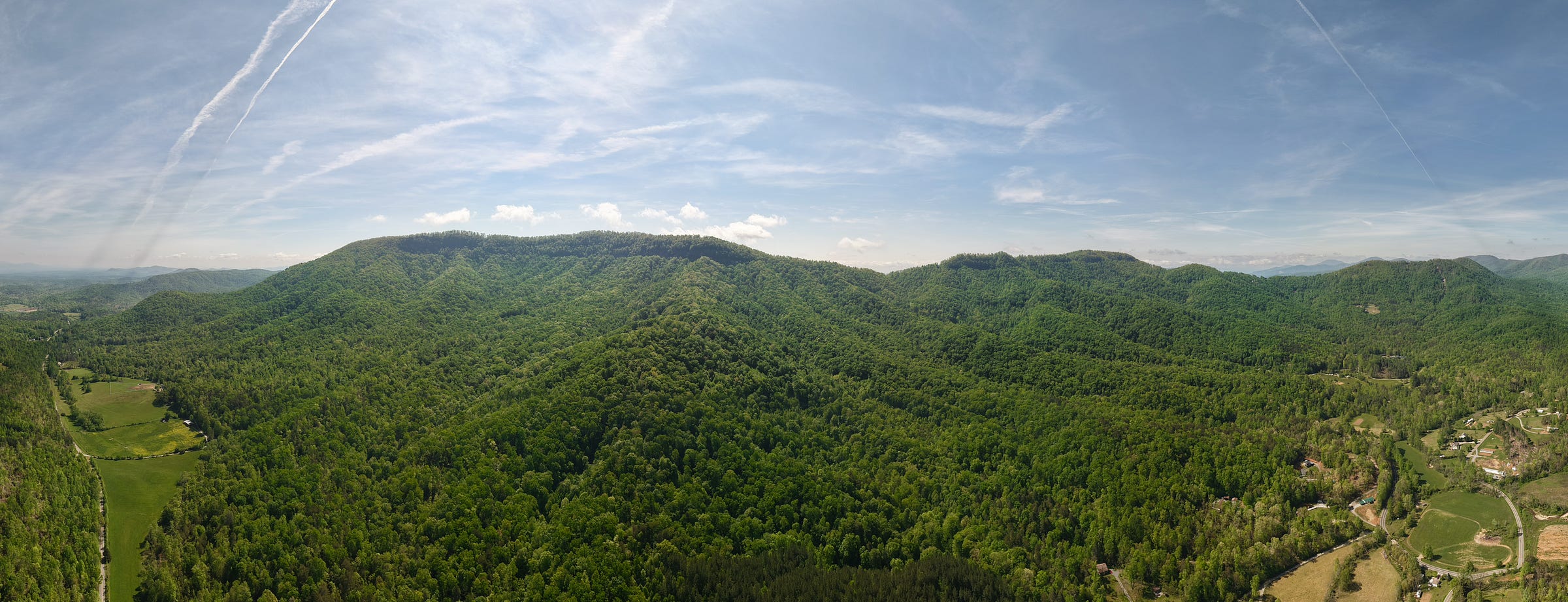12,000-Acre Hickorynut Mountain Could Become Western NC's Newest Protected Wilderness
Foothills Conservancy is raising $28 million to protect Hickorynut Mountain's 12,000 acres in McDowell County, perhaps western North Carolina's largest remaining private tract of wilderness.

Hickorynut Mountain Boasts ‘the Best View in the Blue Ridge’
After driving hardy ATVs for 45 minutes on untamed forest roads through thick woods populated by pines, oaks, hickories, and maples, you reach the summit of Hickorynut Mountain, the overlook for roughly 12,000 acres, perhaps the largest privately owned tract of land remaining in western North Carolina. The views are astonishing.
Looking northward across the Catawba Valley, Old Fort is backdropped by the Blue Ridge and Black Mountains, their peaks instantly recognizable to local outdoors enthusiasts and environmentalists: Mount Mitchell (6,684’), Big Tom (6,595’), and Mount Craig (6,647’), some of the highest peaks in the state—and the eastern United States—are visible from the top of Hickorynut Mountain.
Standing a little above 3,200 feet, Hickorynut is dwarfed by its mountain neighbors, but boasts “one of the best, if not the best view in the Blue Ridge,” argues Michael Gaffney, Conservation and GIS Specialist for Foothills Conservancy of North Carolina (FCNC), the region’s largest land trust.
A private environmentalist currently holds the deed to the expansive tract of forest and intends to transfer ownership to FCNC for $28 million, no small amount for an organization that has protected more than 71,500 acres during its 30-year history.
“In the land conservation world, it’s a once-in-a-lifetime opportunity to protect something of this scale,” says Katherine Ehrlichman, Marketing and Development Director at FCNC.
The current owner has no intention of selling the property to anybody else, so it remains “loosely protected”; but, if the owner’s estate decides to liquidate assets or pursue other outcomes later down the road, there’s little to prevent them from doing so.

Home to Rare Plants, Threatened Wildlife, and Old Growth Forests
Raising the necessary funds to purchase and permanently protect the mountain remains urgent.
FCNC has secured six million dollars from the State of North Carolina to preserve this prospective wilderness area and its ecological treasures, with hopes to receive additional grants at the federal level. However, it will take a broader range of funding sources to make this vision a reality.
Not only does Hickorynut contain headwater streams for the Upper Broad and Catawba River watersheds, but is also home to several endangered species, including the northern long-eared and Indiana bats.
These vast forests also provide habitat for nine rare plants, a threatened salamander, and a threatened spider species, as well.
And while the majority of the land was previously logged for decades, the more difficult areas to access on Hickorynut Mountain retain old growth forests, roughly 140 acres.
Only 1% of the forests throughout the United States, including vulnerable sections on Mount Mitchell, are considered old growth, a qualifier typically applied to diverse woodlands with large trees ranging from 120-200+ years old, depending on the species.
Some of these arboreal stands have never been logged.
40 Miles of New Trails Planned for Hickorynut Mountain State Park
Gaffney believes conserving Hickorynut Mountain will bring a bevy of benefits once in public ownership.
FCNC plans to designate two-thirds as a state park or natural area, while transferring the remaining third to the North Carolina Wildlife Resources Commission.
The foothills region is already a major hub for numerous state and interstate trails, with an additional 40 miles of the Wilderness Gateway State Trail planned for Hickorynut Mountain once it's officially acquired.
Paired with several popular trails and parks in the foothills, Hickorynut is likely to “pull in a huge number of tourism dollars into McDowell County,” Gaffney says, which already benefits from having the beloved Catawba Falls, Linville Falls, and Lake James nearby. “We anticipate it being a huge driver for tourism dollars coming out of Asheville. That 45-minute marker is an ideal distance for people who are on vacation and want to take a little drive out into the country for a hike or mountain bike ride.”
But much more is at stake than tourism dollars and rare species. Protecting 12,000 acres of forest, which contains the headwaters of the Catawba and Upper Broad rivers, means securing clean drinking water and agricultural inputs for the future.
These forests also sequester an enormous amount of carbon, offsetting the amount released into the atmosphere, a major contributor to worsening climate change catastrophes, such as Hurricane Helene, which battered the region last fall.
McDowell County Commissioners Back $28 Million Conservation Purchase
It’s been profound to witness the local support for this project, Gaffney says, recalling when he presented it to the McDowell County Commissioners in March 2025, uncertain how they might react.
His presentation, however, was met with not only enthusiasm from the board but also sparked a childhood memory for Chairman Tony Brown, recollecting his youth spent hunting and camping on Hickorynut Mountain. Looking around among the rhododendron and understory, he remembers his father telling him, “‘Son, you boys enjoy this, because one day it will be covered in houses.’ I am so glad that that isn’t going to happen.”





